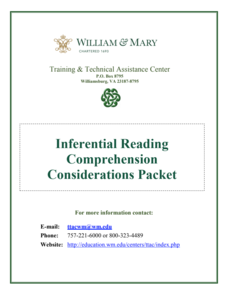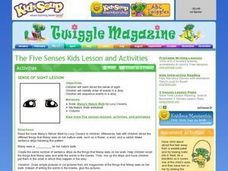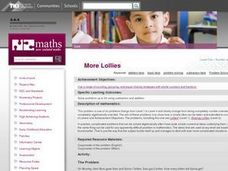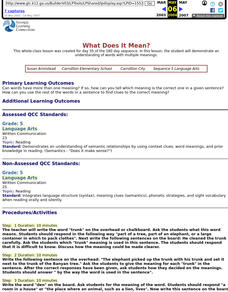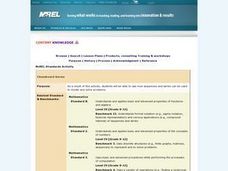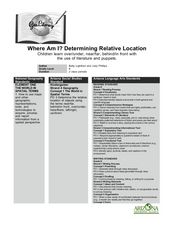EngageNY
Dividing by (x – a) and (x + a)
Patterns in math emerge from seemingly random places. Learners explore the patterns for factoring the sum and differences of perfect roots. Analyzing these patterns helps young mathematicians develop the polynomial identities.
Do2Learn
Social and Emotions Picture Cards
Social and emotional skills are a difficult task for people with autism to master. Help them become more aware of day-to-day emotions as well as how to express them with this massive set of picture cards.
Fluence Learning
Construct Viable Arguments About Adding Fractions
Test mathematicians' knowledge of adding fractions with a brief assessment that challenges them to play teacher while correcting a peer's work. Scholars examine Carl's mathematical response, identify where he went wrong,...
William & Mary
Inferential Reading Comprehension Considerations Packet
Don't forget to read between the lines! Educators learn tips and activities to help scholars learn to infer to increase reading comprehension. Activities suggested include think alouds, backwards words, and who's who. the packet includes...
Curated OER
Finding the Main Idea
The carnival is in town! After reading a short excerpt about a day at the carnival, learners use details to determine the story's main idea. They must differentiate the details from the big picture, as there are multiple options they can...
Illustrative Mathematics
Assessing Writing Numbers
Can I say a number by its name, and can you write it for me? Working in small groups or with the whole class, give your kindergartners a piece of 1-inch graph paper and have them write numbers 0 to 10 and 11 to 20. Next, pass out blank...
Perkins School for the Blind
What Would You Do If...?
What would you do if...? That's a great question, and, when posed to learners with visual impairments, a question that can foster concept development and speaking and problem-solving skills that relate to real-life situations. The...
Curriculum
Expository Writing
The beauty of the way this expository writing resource is structured is that the units can be presented as a complete writing workshop or sequenced throughout a course of study
Curated OER
Timelines
First graders examine what a timeline is and how it shows a sequence of events. They look at a timeline of the teacher's life before they design a timeline of their own based on major events in their lives. Finally, they right one event...
Curated OER
Sense of Sight Lesson
Students sequence what they saw in the book Maisy's Nature Walk. In this sequencing lesson plan, the teacher reads the book and the children listen and observe. Once the book is read, the students have to sequence what Maisy saw on her...
Curated OER
More Lollies
Students review the days of the week and see if the students can recite he sequence using different starting days. Students retell the problem using their own words to check that everyone examines.
Curated OER
What Happened Next?
Fifth graders read one short story on their own. After reading, they are given a series of sentences and events from the short story and put them into the correct sequence. To end the lesson, they draw pictures from the story and...
Curated OER
Manipulating Sound
Students use music software to create and refine a musical composition. They use music software to create a sequence of musical phrases. Students use music software to create and refine a musical composition and adapt it in the light...
Curated OER
What Does It Mean?
Students demonstrate an understanding of words with multiple meanings. They give the meaning for each "trunk" in the sentence.
Curated OER
Lesson Plan on Migration
Fourth graders diagram written and oral directions of a Native American, European Viking, Right Whale or Humpback Whale migration route, the student diagram all directions only in the sequence given, with arrows indicating direction of...
Curated OER
Chessboard Series
High schoolers work together on a word problem. They write a written report of the answer. They participate in a chessgame in which the answers are used.
Curated OER
Relationships and Biodiversity Lab Practice
In this biodiversity worksheet, students determine the relationship and complete the evolutionary tree for the plants listed. Students review genetic code and DNA sequencing. This worksheet has 1 graphic organizer, 8 multiple choice, and...
Curated OER
Trees
Fourth graders discuss the function of roots, trunk, crown, bark, cambium heartwood, and leaves of a tree. They create a tree diagram and label roots, trunk, crown, bark, cambium heartwood and leaves when shown a list of parts and an...
Curated OER
Where Am I? Determining Relative Location
Students use position words to describe where their teacher is sitting and read a story that makes use of position words. In this spatial lesson, students make a stick puppet and play Simon Says focusing on using position words in the...
Curated OER
Mary Had a Little Lamb
Pupils examine the story Mary Had a Little Lamb. In this language arts lesson, students discuss the story and read companion poems. Pupils identify the rhyming words in the story. Students discuss lambs and sheep.
Curated OER
Where Math Meets Poetry
Students identify Fibonacci's sequence of numbers and use the pattern to write poetry with one syllable words. In this math and writing lesson, students identify Fibonacci's sequence of numbers and learn about this early mathematician....
Curated OER
Poultry in Motion (The Little Red Hen Meets Chicken Little)
Students read stories and use reading and writing skills to sequence, compare and contrast, predict, and identify parts of a story. Six lessons on one page.
Curated OER
In My Life
Third graders sequence an important event that has happened in their life. In this sequencing lesson plan, 3rd graders complete a worksheet that is provided.
Curated OER
Comprehension Through The Very Hungry Caterpillar
Students sequence seven events from "The Very Hungry Caterpillar" by matching the correct event with the day of the week. They recall details from the story as they unscramble words on a worksheet.
Other popular searches
- Signal Words Sequence
- List of Sequence Words
- Time Sequence Words
- Writing Using Sequence Words
- Writing With Sequence Words
- Writing Sequence Words
- Sequence Words in Writing
- Time Sequence Words Only



